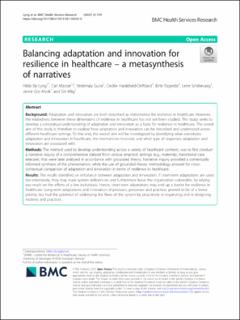| dc.contributor.author | Lyng, Hilda Bø | |
| dc.contributor.author | Macrae, Carl James | |
| dc.contributor.author | Guise, Veslemøy | |
| dc.contributor.author | Haraldseid-Driftland, Cecilie | |
| dc.contributor.author | Fagerdal, Birte | |
| dc.contributor.author | Schibevaag, Lene | |
| dc.contributor.author | Alsvik, Janne Gro | |
| dc.contributor.author | Wiig, Siri | |
| dc.date.accessioned | 2021-12-08T10:30:54Z | |
| dc.date.available | 2021-12-08T10:30:54Z | |
| dc.date.created | 2021-08-10T18:49:46Z | |
| dc.date.issued | 2021-07 | |
| dc.identifier.citation | Lyng, H.B., Macrae, C., Guise, V., Haraldseid-Driftland, C., Fagerdal, B, Schibevaag, L., Alsvik, J.G., & Wiig, S. (2021) Balancing adaptation and innovation for resilience in healthcare – a metasynthesis of narratives. BMC Health Services Research, 21, article: 759 (2021). | en_US |
| dc.identifier.issn | 1472-6963 | |
| dc.identifier.uri | https://hdl.handle.net/11250/2833323 | |
| dc.description.abstract | Background
Adaptation and innovation are both described as instrumental for resilience in healthcare. However, the relatedness between these dimensions of resilience in healthcare has not yet been studied. This study seeks to develop a conceptual understanding of adaptation and innovation as a basis for resilience in healthcare. The overall aim of this study is therefore to explore how adaptation and innovation can be described and understood across different healthcare settings. To this end, the overall aim will be investigated by identifying what constitutes adaptation and innovation in healthcare, the mechanisms involved, and what type of responses adaptation and innovation are associated with.
Methods
The method used to develop understanding across a variety of healthcare contexts, was to first conduct a narrative inquiry of a comprehensive dataset from various empirical settings (e.g., maternity, transitional care, telecare), that were later analysed in accordance with grounded theory. Narrative inquiry provided a contextually informed synthesis of the phenomenon, while the use of grounded theory methodology allowed for cross-contextual comparison of adaptation and innovation in terms of resilience in healthcare.
Results
The results identified an imbalance between adaptation and innovation. If short-term adaptations are used too extensively, they may mask system deficiencies and furthermore leave the organization vulnerable, by relying too much on the efforts of a few individuals. Hence, short-term adaptations may end up a barrier for resilience in healthcare. Long-term adaptations and innovation of products, processes and practices proved to be of a lower priority, but had the potential of addressing the flaws of the system by proactively re-organizing and re-designing routines and practices.
Conclusions
This study develops a new conceptual account of adaptation and innovation as a basis for resilience in healthcare. Findings emerging from this study indicate that a balance between adaptation and innovation should be sought when seeking resilience in healthcare. Adaptations can furthermore be divided into short-term and long-term adaptations, creating the need to balance between these different types of adaptations. Short-term adaptations that adopt the pattern of firefighting can risk generating complex and unintended outcomes, but where no significant changes are made to organization of the system. Long-term adaptations, on the other hand, introduce re-organization of the system based on feedback, and therefore can provide a proactive response to system deficiencies. We propose a pattern of adaptation in resilience in healthcare: from short-term adjustments, to long-term reorganizations, to innovations. | en_US |
| dc.language.iso | eng | en_US |
| dc.publisher | BioMed Central | en_US |
| dc.rights | Navngivelse 4.0 Internasjonal | * |
| dc.rights.uri | http://creativecommons.org/licenses/by/4.0/deed.no | * |
| dc.subject | helse- og sosialfag | en_US |
| dc.subject | metasyntese | en_US |
| dc.title | Balancing adaptation and innovation for resilience in healthcare – a metasynthesis of narratives | en_US |
| dc.type | Peer reviewed | en_US |
| dc.type | Journal article | en_US |
| dc.description.version | publishedVersion | en_US |
| dc.rights.holder | © The Author(s) 2021 | en_US |
| dc.subject.nsi | VDP::Medisinske Fag: 700::Helsefag: 800 | en_US |
| dc.source.pagenumber | 13 | en_US |
| dc.source.volume | 21 | en_US |
| dc.source.journal | BMC Health Services Research | en_US |
| dc.identifier.doi | 10.1186/s12913-021-06592-0 | |
| dc.identifier.cristin | 1925197 | |
| dc.relation.project | SHARE - Centre for Resilience in Healthcare: 5091 | en_US |
| dc.relation.project | Norges forskningsråd: 275367 | en_US |
| dc.source.articlenumber | 759 (2021) | en_US |
| cristin.ispublished | true | |
| cristin.fulltext | original | |
| cristin.qualitycode | 2 | |

